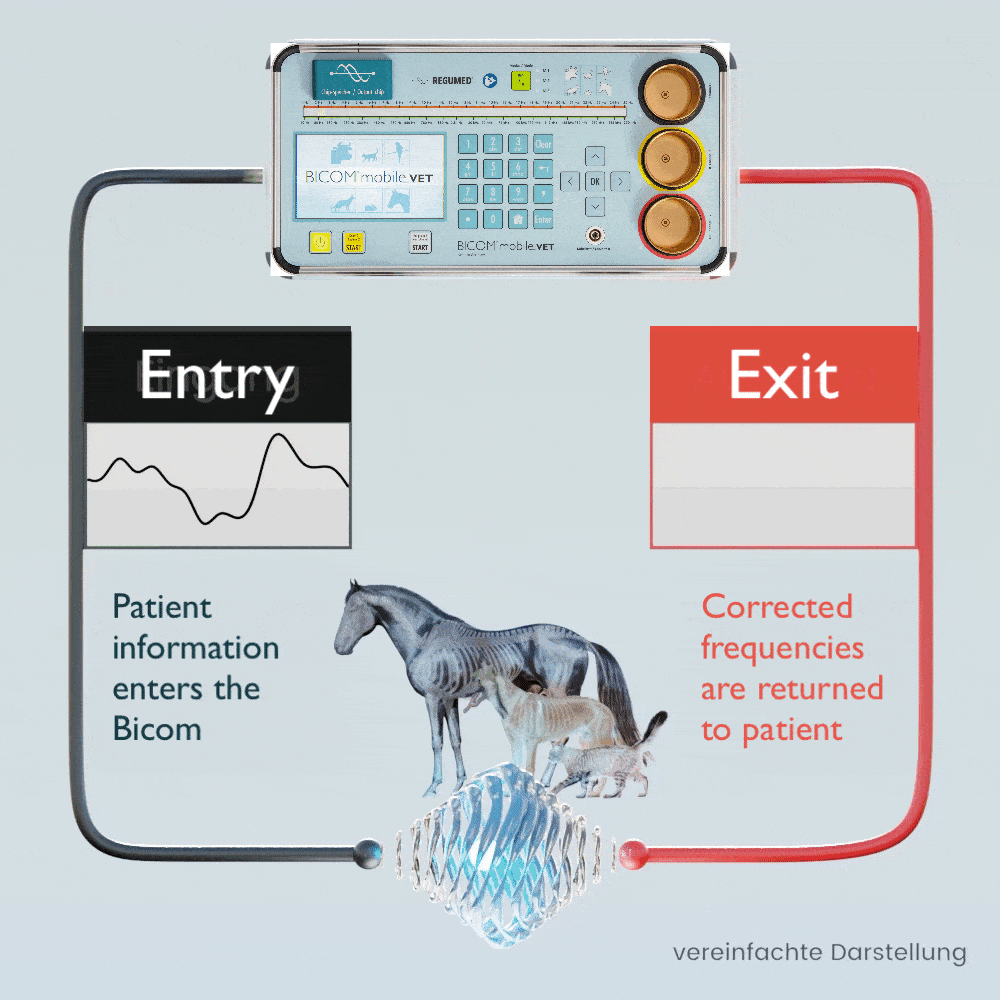Treatment with the help of the patient’s own information
in the BICOM® mobile VET bioresonance device
In contrast to other “frequency therapy devices”, BICOM® bioresonance is a method that is highly individual and perfectly tailored to the needs of the patient through the use of the patient’s own information and the possibility of testing specific wave patterns for resonance.
The patient’s own pathological and physiological information is recorded using special applicators and fed into the BICOM® mobile VET.
Depending on the therapy program, the specific wave pattern as a carrier of information is amplified, weakened or inverted and transmitted back to the patient in modulated form, which means that the transmission of information changes in clarity depending on the modulation or it disappears completely.
The treatment signals continuously adapt to the changing pathological situation of the patient. As the therapy progresses, the body’s ability to regulate is reactivated.
Find out more about this topic at our regular events. Together with veterinarians and animal naturopaths, we offer various face-to-face and online events .
The BICOM® bioresonance method is a cause-oriented, holistic treatment concept. It can narrow down the cause of the health problem in animals and find out even the hidden causes of the clinical picture.
Animals have a natural regulatory system that can also compensate for unusual influences. However, even good self-healing powers eventually reach their limits. Persistent exposure to allergens, environmental toxins, fungi, viruses, bacteria or stress and changed living conditions weaken the immune system and are often the cause of an illness. In particular, fungal infestation on the skin or chronic diseases in general are not always due to a breeding-related genetic defect, but are signs of a disturbed immune system.
The BICOM® bioresonance method is the key to successful diagnosis and therapy, especially for animals that cannot tell us exactly where it hurts or what the symptoms are. It is a gentle form of therapy that can be carried out without side effects and without additional stress for the animal.
The BICOM® mobile VET records the bioenergetic state of the animal, processes the information it contains and returns modified vibrations / therapy frequency patterns to the animal. Symptoms and stress can be diagnosed and targeted therapy can be initiated.
Through the use of endogenous and exogenous substances, the body’s own self-healing powers can be activated and imbalances that have existed for a long time can also be regulated.
REGUMED Medizintechnik are pioneers of the BICOM® bioresonance method. More than 30,000 therapists worldwide, well over 10,000 of them in Germany, successfully use their therapy concept.

Biophysical basics of the bioresonance method
Life is only possible when three conditions are met: matter, energy and information.
We also find these aspects in conventional medicine, both in diagnostics and in therapy. For example, every drug is also a carrier of information.
Information is neither energy nor matter, it is immaterial and comparable to the meaning of a message from a sending to a receiving system.
In addition to the electrical processes in the receptor proteins and biomembranes in general, electromagnetic interactions through light (biophotons) also play a role in cell communication and the transmission of information.
Specific electromagnetic wave patterns act as information carriers. These wave patterns can be modulated by the BICOM® device in order to eliminate disturbing or stressful information in an organism.
The goal is to restore the free flow of healing information (cell communication) and thus support the self-regulation of the organism and the self-healing powers.
Individual, patient-specific information or information from native substances, digitized substances or information stored on storage media can be used for therapy.
What your colleagues are saying…

Lyme disease might be the cause of symptoms you are experiencing
Thanks to the advancements in the medical industry and especially the technological inventions that scientists are able to develop today, it is now possible to diagnose and treat thousands of different diseases successfully. Unfortunately, even though the medical industry has come such a long way, there are still some diseases that remain somewhat of a mystery to medical professionals in one way or another. Lyme disease is one of these particular diseases that tend to baffle scientists, doctors, and even specialists. The disease often represents itself as another type of health ailment since its symptoms are often associated with other conditions, which makes it difficult to identify the disease at an early stage in many cases – and early diagnosis, just like with most other diseases, often leads to a more successful outcome.
What Is Lyme Disease?
Before we dig deeper into how the symptoms of Lyme disease often leads a patient and even their healthcare provider to a misdiagnosis due to the similarity that the particular disease has with other conditions, we should first discuss what Lyme disease is.
It is important to know that Lyme disease is a type of bacterial infection. With this in mind, it becomes quite obvious that the disease needs prompt and adequate treatment since bacterial infections can get rather nasty when left unattended. The disease is transmitted to the human body by a deer tick – these ticks are also known as lxodes ticks. In certain parts of the world, the bacterial infection can also be transmitted by the black-legged tick, as reported by lymedisease.org.
There is no significant difference in the affected populations to point in a higher risk group, but there is some evidence that points out that the elderly and children seem to be at a slightly higher risk of developing this bacterial infection. Those individuals who are often participating in outdoor activities are also at a higher risk of being exposed to the particular types of ticks that transmit Lyme disease.
How Many People Are Affected By Lyme Disease?
Lyme disease affects much more patients than most tend to think. Even though it is not one of the most commonly discussed diseases, it still takes its toll on the global population. According to the Centers for Disease Control and Prevention, Lyme disease is known to be the most common type of vector-borne disease throughout the entire United States.
Health.com reports that recent estimates suggested that as much as 300,000 patients develop Lyme disease and is diagnosed with this particular disease every year. This estimate is much larger than the actual cases that are reported, which accounts for just over 30,000 cases per year. The statistics offer solid evidence that Lyme disease is a problematic health concern that people should pay attention to – whether they currently have it or not, since it can affect them at any time, regardless of their age, race, gender or current health condition.
The Symptoms Of Lyme Disease?
Now that we have discussed Lyme disease in more detail, let’s focus on the symptoms that the disease causes. As you will notice, the symptoms related to this disease is general symptoms that are often found in other diseases, which is why the disease is often misdiagnosed since many of the patients are unable to remember that a tick had bitten them previously.
76% of patients with early Lyme disease experience fatigue, with 79% of chronic Lyme disease patients experiencing fatigue.
70% of patients with early Lyme disease and with chronic Lyme disease experience headaches.
60% of patients with early Lyme disease experience a fever and sweats. Chills is also not uncommon.
Early Lyme disease also causes muscle pain in more than half of all patients and joint pain in around 48% of diagnosed patients. Neck pain and problems with the patient’s sleep are also common symptoms.
When Lyme disease turns into chronic Lyme disease, it may also lead to an adverse effect on the patient’s mental health by impairing their mental capabilities, as well as leading to symptoms that are associated with depression.
Heart-related health concerns are also rather common amongst patients who are suffering from chronic Lyme disease.
Advancements In Bioresonance Therapy Showing Promising Results For Diagnosing And Treating Lyme Disease
Recent studies that have been conducted on the advancements in bioresonance therapy have shown a lot of promise in diagnosing Lyme disease. Since a misdiagnosis is often possible when a patient with Lyme disease reports their symptoms to a doctor, due to the fact that the symptoms often replicate those of other diseases and conditions, obtaining a scan from a bioresonance device can help to identify whether Lyme disease might, in fact, be behind the symptoms – and, if not, what particular problems are really causing the symptoms to develop.
Conclusion
Lyme disease is more widespread than most people think, and reports claim that over 300,000 people obtain this disease every year. The symptoms that the disease causes are often similar to symptoms that can be caused by a wide range of other diseases and a tick bite is often not the first concern on a doctor’s mind when the symptoms are reported. By turning toward bioresonance therapy, diagnosis can be made promptly and treatment can be more effective.
Treatment Priorities
For gentle and optimal treatment of the causes of diseases in animals
The BICOM® bioresonance method is predestined for use with large and farm animals such as horses , but also with dogs , cats and small animals. The treatment focus of the BICOM® mobile VET is wide-ranging. It is now used for many indications.
It recognises health deficits at an early stage and is used, among other things, for the following symptoms:
sweet itch
Feed intolerances
allergies and related diseases
COB/COPD
leishmaniasis
Lyme disease
anaplasmosis
lameness in horses
hoof ulcer
Poisoning by poisoned baits, plants etc.
mauke
Feline infectious peritonitis (FIP)
Cat flu/cat disease
eye/conjunctivitis
and much more
Get advice now!
Our experts are happy to be there for you personally
Our BICOM® bioresonance experts are available to answer any questions you may have
and will be happy to advise you personally and individually.




Request more information
Quick Links





Facebook
Instagram
Mail